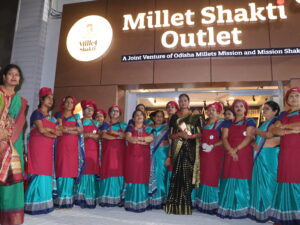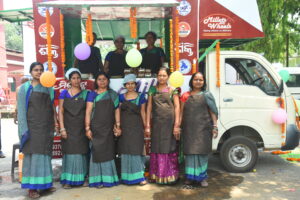When empowered by the system, women can be active agents of change, who can shape their own destinies and that of their households for the better. The Odisha Millet Mission (OMM)is a fine example as a model of agroecology which not only helps farmers to adapt to climate change but also systematically empowers women to play a pivotal role in this transition.
Small-scale farmers in the Global South are vulnerable to climate change in ways that other farmers are not. The predicted decrease in food production due to climate change combined with prevalent factors in these landscapes such as nutritional deficiencies, natural resource degradation, and insecure land tenure compound the risks and vulnerabilities of this demographic sector. Women, in particular, besides facing social vulnerabilities, will disproportionately bear the major burden of climate-change impact in such landscapes. Distress migration, an increasing phenomenon in such landscapes, poses greater risks for women than men.
International climate change discourse in the agricultural sector is predominantly shaped by a Western technocratic approach and oriented towards the needs of the globalised industrial food system. This systematically increases the vulnerabilities of the agrarian communities in the rainfed regions of the Global South in general, and women in particular. Climate policies and funds are predominantly geared towards mitigation and not adaptation measures.
Adaptation is the need of the hour given the precarious nature of smallholder livelihoods. Traditionally, owing to the ecological and social evolution of rainfed agroecosystems, smallholder farmers had adaptive capacities, in terms of knowledge, networks, and management practices to cope with vagaries in the weather. Women have been the custodians of indigenous knowledge (eg., seed varieties or agricultural practices), given their responsibilities to secure food for the households. Adaptive measures undertaken by smallholder farmers included on-farm diversification, adoption of water technologies and management, choice of crop varieties to sow, and strategies to reduce risks. Many of these traditional principles are now incorporated into the growing movement of agroecology.
Elements of agroecology
Agroecology, or the application of social and ecological principles for the design and management of sustainable food systems, is now recognised as a promising pathway to transform our current unsustainable food systems. Since 2019, UN FAO has popularised “10 Elements of Agroecology” as an operational framework for the transformation of food systems towards adaptation and resilience. Of these 10 elements, “recycling, efficiency, diversity, resilience and synergies” are central ecological features, while an additional five elements, namely “co-creation of knowledge, human and social values, culture and food traditions, responsible governance, and circular and solidarity economy” cover the social and political aspects of agroecology. “Agroecology Europe,” a European association, has further added to the FAO framework by suggesting interventions needed to scale agroecology. Gender inclusion in agroecology is not explicitly mentioned but is implicit in its social and political principles. While field evidence has conclusively proved that farming systems using an agroecological framework have increased resilience and adaptation capacities, there are still not enough instances on the ground of how to scale agroecology. The Odisha Millet Mission could well be a singular example in the world that has successfully incorporated all the elements of agroecology in its operational framework. Recognizing this, UN-FAO is studying the agroecological framework of Odisha Millets Mission for its applicability to other countries in the world.
Odisha Millets Mission
Odisha Millets Mission (OMM) is a flagship initiative of the Government of Odisha, started in 2017, to revive millets with a plate-to-farm approach across the state. It is a pioneering initiative by the Department of Agriculture and Farmer’s Empowerment in which consumption is central to the food system to address nutritional deficiencies. It is aimed to achieve by increasing household consumption of nutrition-rich finger millet as well as procuring and distributing it in state nutrition programmes, including the Public Distribution System. OMM is currently operational in all 30 districts of Odisha. As of March 2023, the OMM has covered 264,000 hectares, benefitting 202,784 millet farmers.This paper documents the agroecological features and the impact of OMM in reducing the vulnerabilities faced by rural women.
Agroecology is defined by principles and not by ordained practices. Te extent to which any food or farming system is agroecological can be evaluated by determining the number of agroecological elements and/or levels it includes. The five hierarchical levels identified by Agroecology Europe allow us to determine the scale of an agroecological system (Figure 1).
Figure 1: Agroecological levels and principles
How women have benefitted at each level
Documented below is an analysis of some of the design features of OMM at each of these levels, with examples of how women have been empowered at each of these levels.
a) Level 5 (Agroecological principles: Participation, Localness, Fairness, and Justice)
According to Tittonel et al (2020) recognize that scaling agroecological systems from fields to the entire sector requires that the number and complexity of integrating stakeholders at each level increases. The very aim of this government programme to promote healthy public diets with multiple stakeholders ensures that, as an agroecological initiative, the design of OMM, incorporates the highest levels in the agroecological framework (Figure 1) i.e. levels 4 and 5.

Opening of Millet Shakthi Outlet
OMM integrates the participation of stakeholders at different levels through a decentralised approach. Stakeholders include national and international institutes for research and training purposes, government departments for channeling public investments, SHGs, FPOs, and NGOs as Facilitating Agencies in each of the 143 Blocks of the programme to help with implementation. As of March 2023, 116 FPOs (all of which included women farmers and some of which were run solely by women) and 1,869 women SHGs (WSHGs) were part of OMM. Fair and assured prices, local procurement of millets, inclusion of small and marginal farmers, and gender sensitivity, are all hallmarks of the OMM, which has resulted in a widescale shift of the entire food system to climate-resilient millets. With financial support for capital expenditure and training provided by the government, women farmers have emerged as entrepreneurs in this millet value chain and operate primary and secondary millet-processing enterprises. As of August 2023, there were 1382 millet processing units and 229 food outlets run by women, which earns them a steady monthly income, contributing to their social and economic empowerment.
b) Level 4 (Agroecological principles: Development of alternative food networks)
An alternative millet food system has been successfully developed by creating market demand along with highly successful behaviour change campaigns. This has been achieved by making policy shifts for procuring millets in bulk and including them in state nutrition programmes. Women SHGs were supported to be entrepreneurs to cater to private markets. WSHGs serve millet-based street food and supply ready-to-cook or ready-to-eat millet items to state nutrition centers as well as to private outlets.

Millets on Wheels reaches consumers directly
WSHGs operate 4 different types of food outlets of different sizes, catering to different segments of the population. Start-up capital for these outlets is provided by the government, while the WSHGs take care of all operational costs. For the smallest food outlet, a millet tiffin center, the monthly turnover is Rs. 30,000 per unit while that of a Millet Shakti Café, the largest type of food outlet in OMM, is Rs. 200,000 per unit. Millets have been piloted for inclusion in Anganwadis or state nutrition centers for children in 2 districts under OMM. In one of the districts, Keonjhar, all the Anganwadis serving 27,000 children are provided with 8 millet ladoos (sweetmeats) every month. 59 WSHGs, currently involved in supplying the millet flour for the ladoos, report a monthly profit of Rs. 30,000/- through this venture. The WSHGs who make and sell ladoos to Anganwadis make an average monthly profit of Rs.16500.
c) Level 3 (Agroecological principle: Redesign Agroecosystems)
Reviving the biodiversity of ecosystems is an agroecological element and key to building resilience to climate change. OMM set up support systems for researching farmers’ preferred landraces through participatory varietal trials. Production and consumption of millets were decentralised. To ensure the accessibility of superior quality seeds of different landraces community-managed seed centres (CMSCs) were set up in each block. These CMSCs are managed by registered Farmer Producer Organisations (FPOs) that procure seeds from individual farmers. Standard operational protocols for seed purification, treatment and multiplication for the market have been established. Women farmers and WSHGs are involved in the processes of treating the seeds with bio-inputs, procurement and sale.
d) Level 2 (Agroecological principle: Agroecological alternatives)
OMM provided the necessary support systems in terms of generating awareness, training and providing start-up capital that allowed farmers to switch to use of bio-inputs. Looking into the growing market demand, Maa Hingula women’s SHG in the Mayurbhanj district, with financial support and technical guidance of Jashipur Farmers Producers Company Limited (JFPCL) started a bio-input unit in the year 2020. At that time, the market in the Block (local administrative unit) for these bio-inputs was estimated at 5000 liters and projected to grow further. Looking at this increasing demand for bio inputs, the SHG is ready to scale up its production. As JFPCL takes the responsibility of marketing, SHG members are quite hopeful of a secure income stream in the future. They are also happy that people are using their inputs not only in millet cultivation but also in paddy and vegetable cultivation.
|
Box 1 Jyoti, a landless labourer in the Sundergarh district, took to share-cropping of one acre of land in her village that was lying fallow. Having got trained through OMM, she followed the agronomic practices and also prepared and used her own bio-inputs. She reported an increase in yield over time. With enhanced income, she brought more fallow land into cultivation and planted other crops along with the main millet crop for the market. She further diversified her agricultural income with backyard poultry and selling vermicompost to other farmers in the locality. This progressive farmer inspires other farmers to follow suit, and she personally encourages other women farmers to diversify food production, pointing to the benefits of better nutrition and increased income. |
e) Level 1 (Agroecological principle: Increase efficiency of input use)
OMM trained farmers in agroecological practices to improve yield productivity and increase the efficiency of inputs. Farm implements, such as cycle weeders, needed for such practices were also made available to farmers through custom hiring centers. Farmers have reported several benefits such as decreased input costs, greater productivity, lower GHG emissions, reduced water usage, and improvement of soil quality. In their independent evaluation, the World Food Programme commended OMM for its gender inclusion, particularly noting that the cycle weeder was gender friendly in its design.
Conclusion: Large-scale agroecological systems as adaptative measures
OMM promoting a large-scale agroecological system, has helped thousands of agrarian households to develop better resilience to climate change. The adaptation measures of OMM encompass the technological, ecological, social and governance principles of the agroecology framework. These adaptation measures have led to increased livelihood opportunities, increased income, and better nutrition. OMM has resulted in co-benefits in terms of women’s socio-economic empowerment.
It is important to include women’s knowledge, experience and perspectives as traditional caregivers in climate change policy and investment frameworks. As demonstrated by OMM, agroecological systems that empower women to play a pivotal role in food and farming build resilience against climate change.
References
https://www.agroecology-europe.org/the-13-principlesof-agroecology/
Tittonell P, Piñeiro G, Garibaldi LA, Dogliotti S, Olff H and Jobbagy EG (2020) Agroecology in Large Scale Farming—A Research Agenda. Frontiers in Sustainable Food Systems. 4:584605.
doi: 10.3389/fsufs.2020.584605
Dr. Bindu Mohanty
Senior Coordinator (Research & Partnerships) of RRA Network Hub
Watershed Support Services and Activities Network (WASSAN)
Plot. No. 685 & 686, Road. No. 12 Narasimhaswamy Colony, Nagole
Hyderabad. 500 068
Telangana
E-mail: bindu@wassan.org
Dr. Bindu Mohanty
Senior Coordinator (Research & Partnerships) of RRA Network Hub
Watershed Support Services and Activities Network (WASSAN)
Plot. No. 685 & 686, Road. No. 12 Narasimhaswamy Colony, Nagole
Hyderabad. 500 068
Telangana
E-mail: bindu@wassan.org









